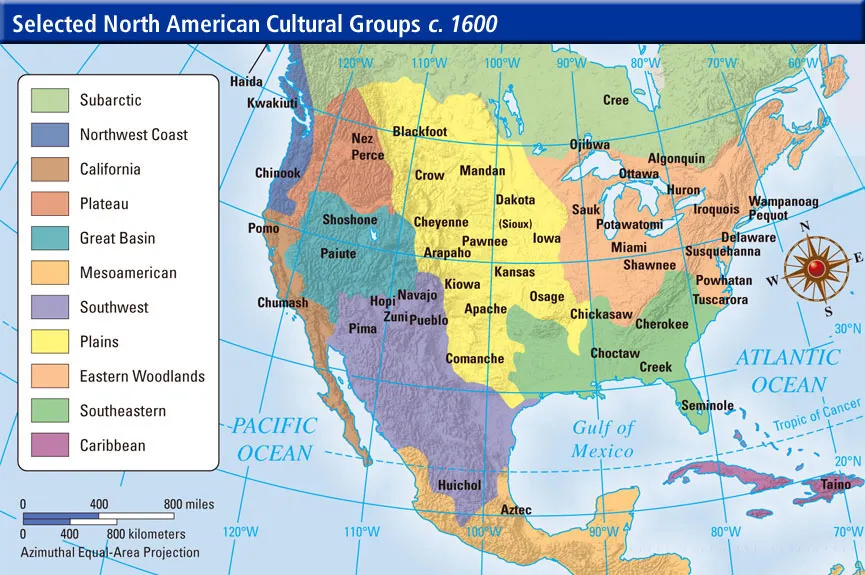The land of Arizona, with its rugged beauty and rich history, has been home to numerous Native American tribes for thousands of years. Prior to the arrival of Europeans, these tribes developed unique cultures, adapted to harsh environments, and built distinctive societies. This article delves into the history and origins of Arizona’s Native American tribes, uncovering their remarkable cultural heritage and enduring historical legacy.
By the late 15th century, when Europeans began exploring North America, the world of Native Americans underwent significant changes. It is estimated that between 3 and 6 million Indigenous people lived in the region before Christopher Columbus and other Europeans arrived. Across the vast continent, Native Americans cultivated vibrant communities with unique economic, social, and cultural characteristics.
The Pueblo Tribes: Descendants of Ancient Civilizations
In the southwestern region, where the climate is harsh, ancient cultures such as the Hohokam, Mogollon, and Anasazi thrived. However, by the 15th century, these civilizations had declined due to droughts and environmental shifts. Their descendants, collectively referred to as the Pueblo people, continued to live in the area, forming smaller tribes including Acoma, Keres, Hopi, and Zuni.
The Hopi, one of the most well-known Pueblo tribes, had a unique matrilineal and matriarchal society. In Hopi communities, women held significant leadership roles in social and political matters. The Clan Mother, often the eldest woman in the family, was entrusted with making key decisions and resolving disputes within the tribe.

Though farming was common among Pueblo tribes, some practiced irrigated agriculture, while others relied on dry farming techniques due to the desert conditions. Their ability to adapt to the natural environment allowed them to endure and prosper for generations.
Apache and Navajo: Nomadic Warriors
In addition to Pueblo tribes, the Southwest was also home to the Apache and Navajo people. Both groups trace their origins to the western plains of Canada and share a linguistic connection. By the 13th century, they began migrating southward, arriving in the Southwest by the 15th century.
Unlike the Pueblo people, the Apache and Navajo had nomadic traditions, traveling frequently between the Southwest and the plains. They sometimes raided other tribes and villages for wealth or revenge. Though their societies were matrilineal, Apache and Navajo cultures maintained patriarchal structures.

The Pueblo people also engaged in raids, often in retaliation or to expand agricultural lands. To protect themselves, Pueblo tribes constructed villages on steep plateaus, with narrow paths and hard-to-reach dwellings. These clever adaptations showcase the ingenuity and resilience of Native Americans in response to environmental and political conditions.
Cultural and Linguistic Diversity
Arizona is a land rich in cultural and linguistic diversity. Native tribes in the region spoke hundreds of different languages, and many were unable to understand the languages of other Indigenous groups. Sign language became a useful tool for trade and communication among tribes with different linguistic backgrounds.

In the 15th century, stark cultural distinctions existed between tribes in the eastern United States. In the southeastern region, dozens of tribes flourished, including the Cherokee, Chickasaw, Choctaw, Creek, and Seminole.
The Impact of European Presence
The arrival of Europeans in the late 15th century drastically transformed the lives of Native Americans across North America. Explorations and colonial expansion brought profound changes to the history and culture of Indigenous tribes.

In the centuries that followed, Native Americans faced wars, diseases, and the loss of their ancestral lands. Despite these challenges, they persisted in preserving their cultural identities and continued contributing to the rich diversity of the United States today.
Conclusion
The history and origins of Arizona’s Native American tribes remain a crucial part of America’s collective narrative. Their cultural contributions and stories of resilience continue to inspire future generations. Learning about the history of these tribes helps us better appreciate cultural diversity and the hardships they have endured in the past. Arizona, with its stunning landscapes and rich heritage, is a fascinating destination for those seeking to explore the unique legacy of Native American cultures.